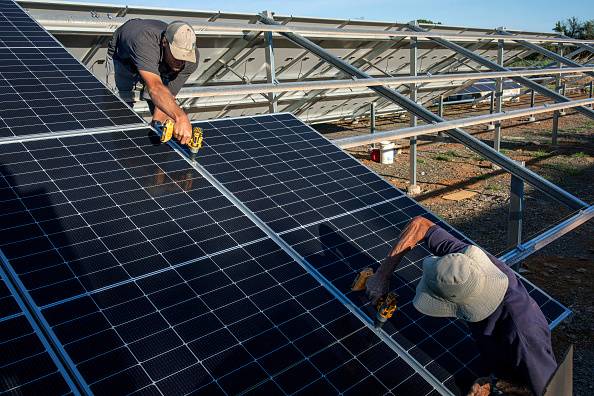
South Africa is expected to create between 85,000 and 275,000 new green jobs by 2030, many of them in energy and power production, agriculture and nature-related sectors. (File photo: Per-Anders Pettersson/Getty Images)
New analysis projects that up to 3.3 million direct green jobs could be created across Africa by 2030, most of them in the renewable energy sector, particularly solar power.
The report provides detailed forecasts for five focus countries: South Africa, the Democratic Republic of the Congo (DRC), Ethiopia, Kenya and Nigeria.
Combined, these countries will account for more than 22 percent of new jobs in key sectors such as renewable energy, e-mobility, agriculture, construction and manufacturing, according to a Shortlist and FSD Africa study and analysis by the Boston Consulting Group.
“Despite accounting for just 3% of global carbon emissions, Africa has unique potential to lead global decarbonization efforts and leverage new green industries,” the report said. “With abundant natural resources, renewable energy potential and the world's largest and growing workforce, Africa can bypass carbon-intensive infrastructure and leapfrog directly into renewable energy,” the report said.
South Africa, Kenya and Nigeria are projected to have the highest job creation potential (16%) due to their population, GDP and industrial maturity. The renewable energy sector is expected to create up to 2 million jobs, of which 1.7 million will be solar photovoltaic (PV) jobs, adding 140,000 in South Africa and 111,000 in Kenya.
Agriculture and nature are expected to create up to 700,000 jobs (25% of the total), with more than half of these (377,000) coming from climate-smart agricultural techniques.
South Africa is projected to have between 85,000 and 275,000 new green jobs by 2030, mainly in energy and power production, agriculture and nature.
Hydropower is projected to be a major employer in both the Democratic Republic of the Congo (16,000) and Ethiopia (33,000). In the Democratic Republic of the Congo, 15,000-45,000 new green jobs are projected to be created by 2030, mainly in energy and electricity production and distribution. In Ethiopia, studies show that 30,000-130,000 new green jobs are expected to be created by 2030, mainly in energy and electricity production.
Nigeria is expected to see aquaculture and poultry farming drive job creation, potentially creating 60,000-240,000 new green jobs by 2030. Kenya is expected to see its solar power sector drive job creation, creating 40,000-240,000 green jobs by 2030, with an estimated 11,000 jobs created by the end of the decade.
“Africa's Green Promise”
The report predicts that 60% of the jobs created by the green economy over the next six years will be skilled or white-collar jobs.
Of these, 10% are predicted to be “high-skilled jobs” (requiring advanced skills and a university degree), a further 30% will be “specialized jobs” (requiring qualifications and vocational training), and 20% will be management roles.
“Importantly, these jobs tend to attract higher salaries and will therefore play a central role in driving the growth of the middle class in countries with these high-growth sectors,” the report said.
Some organizations estimate that a green economy could create up to 100 million new jobs and improved livelihoods in Africa by 2050, but achieving the continent's “green promise” will require supporting policies, infrastructure and financial investments estimated at more than $100 billion per year.
“But successful green economic growth also depends on developing the right human capital and talent. A skilled green workforce is essential to drive and benefit from this growth,” the report said.
While infrastructure, policies and capital flows are frequently analysed, talent supply and demand trends have been “overlooked”.
The authors noted that the short-term projection of more than 3 million new direct jobs being created across 12 subsectors by 2030, while significant, underestimates the broader job creation potential because the study only focuses on jobs created up to 2030, and “the greatest potential lies in the longer term.”
The forecast considered only the 12 most mature subsectors, excluding promising areas such as biofuels, green hydrogen, agroforestry and regenerative agriculture. The forecast also excluded “green-related” sectors such as minerals and mining, which are essential for green growth but are not typically considered green under current practice.
“We believe it is important to start with a narrow view to 2030 because these 3 million more jobs will support the broader growth of the green workforce. Without identifying, training and equipping the talent needed now in Africa's mature industries, larger, longer-term projections may remain mere aspirations,” the authors said.

